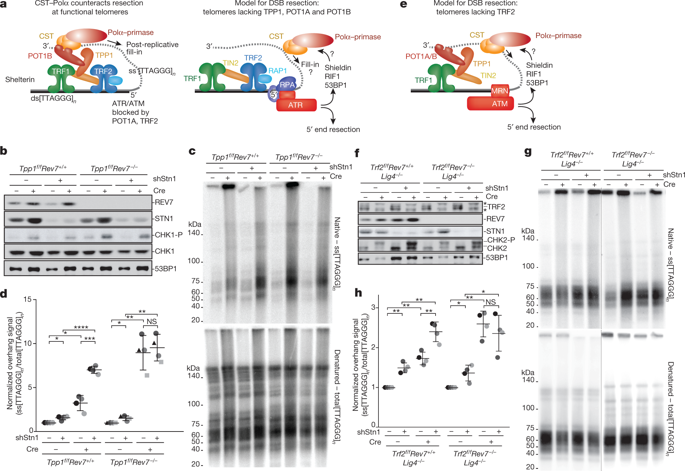Our official English website, www.x-mol.net, welcomes your feedback! (Note: you will need to create a separate account there.)
53BP1–RIF1–shieldin counteracts DSB resection through CST- and Polα-dependent fill-in
Nature ( IF 64.8 ) Pub Date : 2018-07-18 , DOI: 10.1038/s41586-018-0324-7 Zachary Mirman , Francisca Lottersberger , Hiroyuki Takai , Tatsuya Kibe , Yi Gong , Kaori Takai , Alessandro Bianchi , Michal Zimmermann , Daniel Durocher , Titia de Lange
Nature ( IF 64.8 ) Pub Date : 2018-07-18 , DOI: 10.1038/s41586-018-0324-7 Zachary Mirman , Francisca Lottersberger , Hiroyuki Takai , Tatsuya Kibe , Yi Gong , Kaori Takai , Alessandro Bianchi , Michal Zimmermann , Daniel Durocher , Titia de Lange

|
In DNA repair, the resection of double-strand breaks dictates the choice between homology-directed repair—which requires a 3′ overhang—and classical non-homologous end joining, which can join unresected ends1,2. BRCA1-mutant cancers show minimal resection of double-strand breaks, which renders them deficient in homology-directed repair and sensitive to inhibitors of poly(ADP-ribose) polymerase 1 (PARP1)3–8. When BRCA1 is absent, the resection of double-strand breaks is thought to be prevented by 53BP1, RIF1 and the REV7–SHLD1–SHLD2–SHLD3 (shieldin) complex, and loss of these factors diminishes sensitivity to PARP1 inhibitors4,6–9. Here we address the mechanism by which 53BP1–RIF1–shieldin regulates the generation of recombinogenic 3′ overhangs. We report that CTC1–STN1–TEN1 (CST)10, a complex similar to replication protein A that functions as an accessory factor of polymerase-α (Polα)–primase11, is a downstream effector in the 53BP1 pathway. CST interacts with shieldin and localizes with Polα to sites of DNA damage in a 53BP1- and shieldin-dependent manner. As with loss of 53BP1, RIF1 or shieldin, the depletion of CST leads to increased resection. In BRCA1-deficient cells, CST blocks RAD51 loading and promotes the efficacy of PARP1 inhibitors. In addition, Polα inhibition diminishes the effect of PARP1 inhibitors. These data suggest that CST–Polα-mediated fill-in helps to control the repair of double-strand breaks by 53BP1, RIF1 and shieldin.53BP1 and shieldin recruit the CTC1–STN1–TEN1 complex and polymerase-α to sites of DNA damage to help control the repair of double-strand breaks.
中文翻译:

53BP1–RIF1–shieldin 通过 CST 和 Polα 依赖性填充来抵消 DSB 切除
在 DNA 修复中,双链断裂的切除决定了同源定向修复(需要 3' 突出端)和经典的非同源末端连接(可以连接未切除的末端)1,2 之间的选择。BRCA1 突变癌症显示双链断裂的最小切除,这使得它们缺乏同源定向修复并且对聚(ADP-核糖)聚合酶 1 (PARP1)3-8 的抑制剂敏感。当 BRCA1 不存在时,双链断裂的切除被认为被 53BP1、RIF1 和 REV7–SHLD1–SHLD2–SHLD3(shieldin)复合物阻止,并且这些因子的缺失会降低对 PARP1 抑制剂的敏感性4,6-9。在这里,我们解决了 53BP1-RIF1-shieldin 调节重组基因 3' 突出端产生的机制。我们报告说 CTC1–STN1–TEN1 (CST)10,一种类似于复制蛋白 A 的复合物,作为聚合酶-α (Polα)-primase11 的辅助因子,是 53BP1 通路的下游效应子。CST 与 shieldin 相互作用,并以 53BP1 和 shieldin 依赖性方式与 Polα 一起定位到 DNA 损伤位点。与 53BP1、RIF1 或 shieldin 的丢失一样,CST 的消耗导致切除增加。在 BRCA1 缺陷细胞中,CST 阻止 RAD51 加载并促进 PARP1 抑制剂的功效。此外,Polα 抑制减弱了 PARP1 抑制剂的作用。这些数据表明 CST-Polα 介导的填充有助于控制 53BP1、RIF1 和屏蔽蛋白对双链断裂的修复。 53BP1 和屏蔽蛋白将 CTC1-STN1-TEN1 复合物和聚合酶-α 募集到 DNA 损伤位点帮助控制双链断裂的修复。
更新日期:2018-07-18
中文翻译:

53BP1–RIF1–shieldin 通过 CST 和 Polα 依赖性填充来抵消 DSB 切除
在 DNA 修复中,双链断裂的切除决定了同源定向修复(需要 3' 突出端)和经典的非同源末端连接(可以连接未切除的末端)1,2 之间的选择。BRCA1 突变癌症显示双链断裂的最小切除,这使得它们缺乏同源定向修复并且对聚(ADP-核糖)聚合酶 1 (PARP1)3-8 的抑制剂敏感。当 BRCA1 不存在时,双链断裂的切除被认为被 53BP1、RIF1 和 REV7–SHLD1–SHLD2–SHLD3(shieldin)复合物阻止,并且这些因子的缺失会降低对 PARP1 抑制剂的敏感性4,6-9。在这里,我们解决了 53BP1-RIF1-shieldin 调节重组基因 3' 突出端产生的机制。我们报告说 CTC1–STN1–TEN1 (CST)10,一种类似于复制蛋白 A 的复合物,作为聚合酶-α (Polα)-primase11 的辅助因子,是 53BP1 通路的下游效应子。CST 与 shieldin 相互作用,并以 53BP1 和 shieldin 依赖性方式与 Polα 一起定位到 DNA 损伤位点。与 53BP1、RIF1 或 shieldin 的丢失一样,CST 的消耗导致切除增加。在 BRCA1 缺陷细胞中,CST 阻止 RAD51 加载并促进 PARP1 抑制剂的功效。此外,Polα 抑制减弱了 PARP1 抑制剂的作用。这些数据表明 CST-Polα 介导的填充有助于控制 53BP1、RIF1 和屏蔽蛋白对双链断裂的修复。 53BP1 和屏蔽蛋白将 CTC1-STN1-TEN1 复合物和聚合酶-α 募集到 DNA 损伤位点帮助控制双链断裂的修复。



























 京公网安备 11010802027423号
京公网安备 11010802027423号